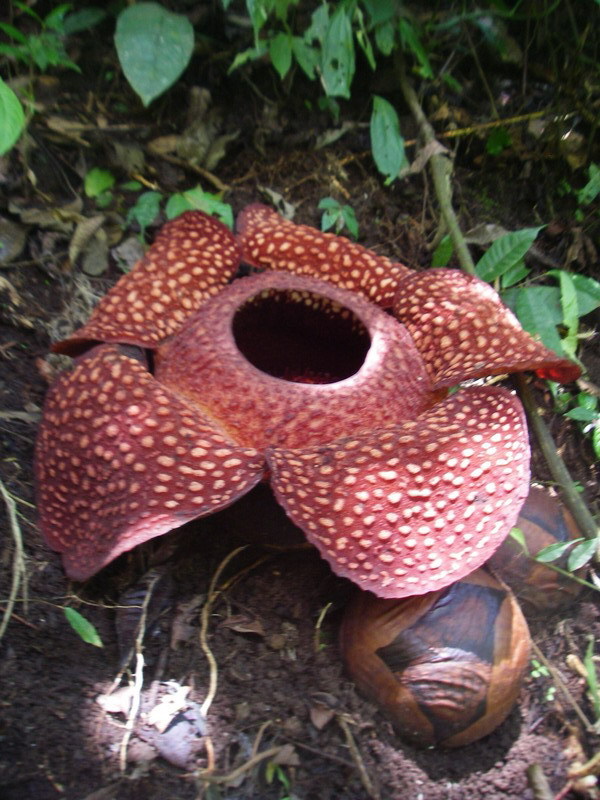This is a strange and rare tree species from Indonesia
1. KANTUNG SEMAR
 |
| sumber: wikipedia |
Semar Pouch Plants
This plant is an insect-eating plant with special features:
Semar bags and venus have a liquid on the leaves to attract attention and trap insects for prey.
Semar bags have the enzyme proteolase or acidic liquid that functions to digest the body of the entangled insects. In the world there are 129 types of this plant and 64 of them are in Indonesia.
Perhaps of all the plants you have ever known, this is the only plant that is very strange because it is considered a carnivorous plant. Semar bags are scattered in Sulawesi, Maluku and Papua.
2. RAFLESIA
 |
| id.wikipedia.org |
Raflesia plants are parasitic plants that live on the roots of other plants. To get its food, Raflesia must take food from other plants because these plants do not have chlorophyll so they cannot carry out photosynthesis or cannot make their own food.
Raflesia plant stems consist of a network of fine threads that grow inside the host plant tissue. Raflesia is only seen when the flower buds penetrate the host plant. After that over time the size of the Raflesia flower will continue to grow.
Raflesia is the largest flower in the world. Raflesia diameter is about 1 meter. The special feature of the Raflesia flower is that it can give off a foul odor like a carcass. The foul odor issued by Raflesia turned out to have a purpose and function.
Raflesia deliberately emits a foul odor like a carcass that functions to attract insects (flies) to come and help pollination. Flies are indeed very beneficial for Raflesia, because Raflesia breed through pollination assisted by flies.
Raflesia deliberately emits a foul odor like a carcass that functions to attract insects (flies) to come and help pollination. Flies are indeed very beneficial for Raflesia, because Raflesia breed through pollination assisted by flies.
3. KEJORA OR VENUS
 |
| biologipedia |
Morning Plants or Venus
In addition to semar bag plants, it turns out there are more plants that are included insectivores. The plant is Venus flytrap or also known as the Kejora plant. Then about how the venus plant catches insects? Is it the same as the Semar bag?
The special feature of the venus or kejora plant is having hinged and hairy leaves whose function is to catch insects. The leaves are open waiting for the insects to come. When the insect touches the fine hairs on the leaf, both parts of the leaf will close quickly
In addition to semar bag plants, it turns out there are more plants that are included insectivores. The plant is Venus flytrap or also known as the Kejora plant. Then about how the venus plant catches insects? Is it the same as the Semar bag?
The special feature of the venus or kejora plant is having hinged and hairy leaves whose function is to catch insects. The leaves are open waiting for the insects to come. When the insect touches the fine hairs on the leaf, both parts of the leaf will close quickly
4. CENDANA
 |
| kumau.com |
Characteristics of Sandalwood
1. In general, sandalwood is yellow sulfur, but some are dark brown.
2. Sandalwood has a very fine texture.
3. Sandalwood has varying fiber directions. Some are straight, bumpy, and some
are combined.
4. According to the indonesianforest.com website, sandalwood from Indonesia has
a medium weight with an average specific gravity of 0.84.
5. Durability of sandalwood is moderate (class II durable).
6. The level of strength of sandalwood is moderate to good (strong class II-I).
7. Sandalwood has shrinkage possibilities that are small to moderate.
8. The cracking power of sandalwood is low to moderate.
9. The hardness level of sandalwood is moderate to hard.
10. The nature of sandalwood work is rather difficult.
1. In general, sandalwood is yellow sulfur, but some are dark brown.
2. Sandalwood has a very fine texture.
3. Sandalwood has varying fiber directions. Some are straight, bumpy, and some
are combined.
4. According to the indonesianforest.com website, sandalwood from Indonesia has
a medium weight with an average specific gravity of 0.84.
5. Durability of sandalwood is moderate (class II durable).
6. The level of strength of sandalwood is moderate to good (strong class II-I).
7. Sandalwood has shrinkage possibilities that are small to moderate.
8. The cracking power of sandalwood is low to moderate.
9. The hardness level of sandalwood is moderate to hard.
10. The nature of sandalwood work is rather difficult.

